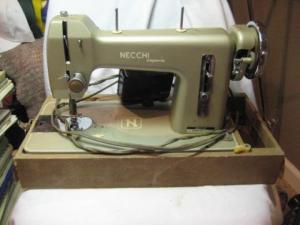 So I know I said the thing about the not hoarding any more machines. Sigh. But then I saw a machine like this, a Bernina 740 favorit, on ebay for super cheap listed by someone who seemed very grandmothery and knowledgeable and loving to her machines and could not, for the life of me, resist buying such a rare and well cared for piece. (image source) I realllly shouldn’t be spending more money on something I don’t need (I can hear the lifepartner now: ANOTHER sewing machine??!?) but I look at these as something like investments, in that I can love them and use them and learn with them but pass them on to other hands if I choose to some day and they probably will still be worth something after my heavy usage. Vintage sewing machines certainly don’t seem to be devaluing, especially high end models; reading sewing blogs from 5 years ago discussing the pricing makes this pretty obvious. And if I can actually apply skills I’ve taught myself to repair them, so much the better for the potential return on my “investments,” should it ever be possible to pry one from my clutches.
So I know I said the thing about the not hoarding any more machines. Sigh. But then I saw a machine like this, a Bernina 740 favorit, on ebay for super cheap listed by someone who seemed very grandmothery and knowledgeable and loving to her machines and could not, for the life of me, resist buying such a rare and well cared for piece. (image source) I realllly shouldn’t be spending more money on something I don’t need (I can hear the lifepartner now: ANOTHER sewing machine??!?) but I look at these as something like investments, in that I can love them and use them and learn with them but pass them on to other hands if I choose to some day and they probably will still be worth something after my heavy usage. Vintage sewing machines certainly don’t seem to be devaluing, especially high end models; reading sewing blogs from 5 years ago discussing the pricing makes this pretty obvious. And if I can actually apply skills I’ve taught myself to repair them, so much the better for the potential return on my “investments,” should it ever be possible to pry one from my clutches.
Berninas are held in high esteem by people all over the interwebz, but I’ve never tried one. I was drooling over a few Record 530, 630 and 730 models for a few months, but the Husqvarnas I’ve been trying vainly to fix really turned me off on anything with plastic innards and tight, enclosed motor free arm body styles. The beautiful thing about the Favorit models is that they are a) flatbed, meaning I can access the lower mechanical parts easily for cleaning and oiling, and b) at least some of them have an externally mounted motor, making for easier belt replacements if needed and even motor replacement if it came to that. The ebay description claimed an all metal construction, so I’m hoping that’s correct, as at least the 730 Record models have plastic parts (cam gear, etc) that do eventually wear out. c) It’s 60slicious. That cream and avocado color scheme. That font. Those curving lines. Why are contemporary sewing machine designs so inattentive to sheer visual pleasure?? This is fun to look at.
Another beautiful thing? Evidently these are possible to rig up to huge industrial motors. Like so:
I have seen 740 Favorit and 730 Industrie models, but am not sure what the difference is in the construction. The motors for the industrie ones are enormous and mounted below the machine, and I’m not sure how the sizes compare. But I will enjoy investigating!
So of course I had to seek out a manual, and was happy to find that Bernina has a page devoted to out of print manuals. (bernina manuals) The translation is clumsy, but it’s kind of part of the charm. The manual for the 740 is (here).
The ol’ girl should be arriving around Christmas time, which means I’ll be enjoying this new baby over some spiked eggnog. Can’t wait!



 (image source)
(image source)


